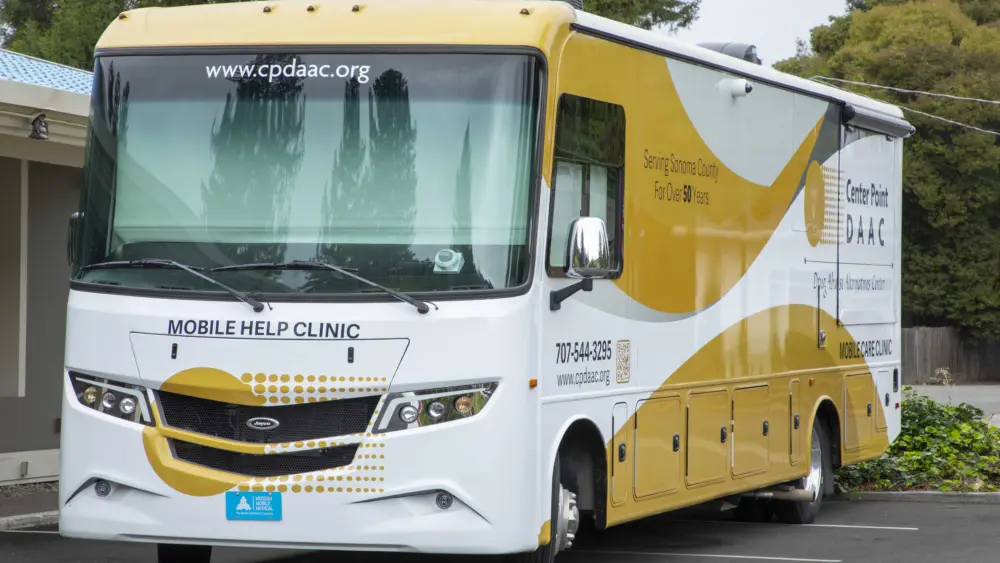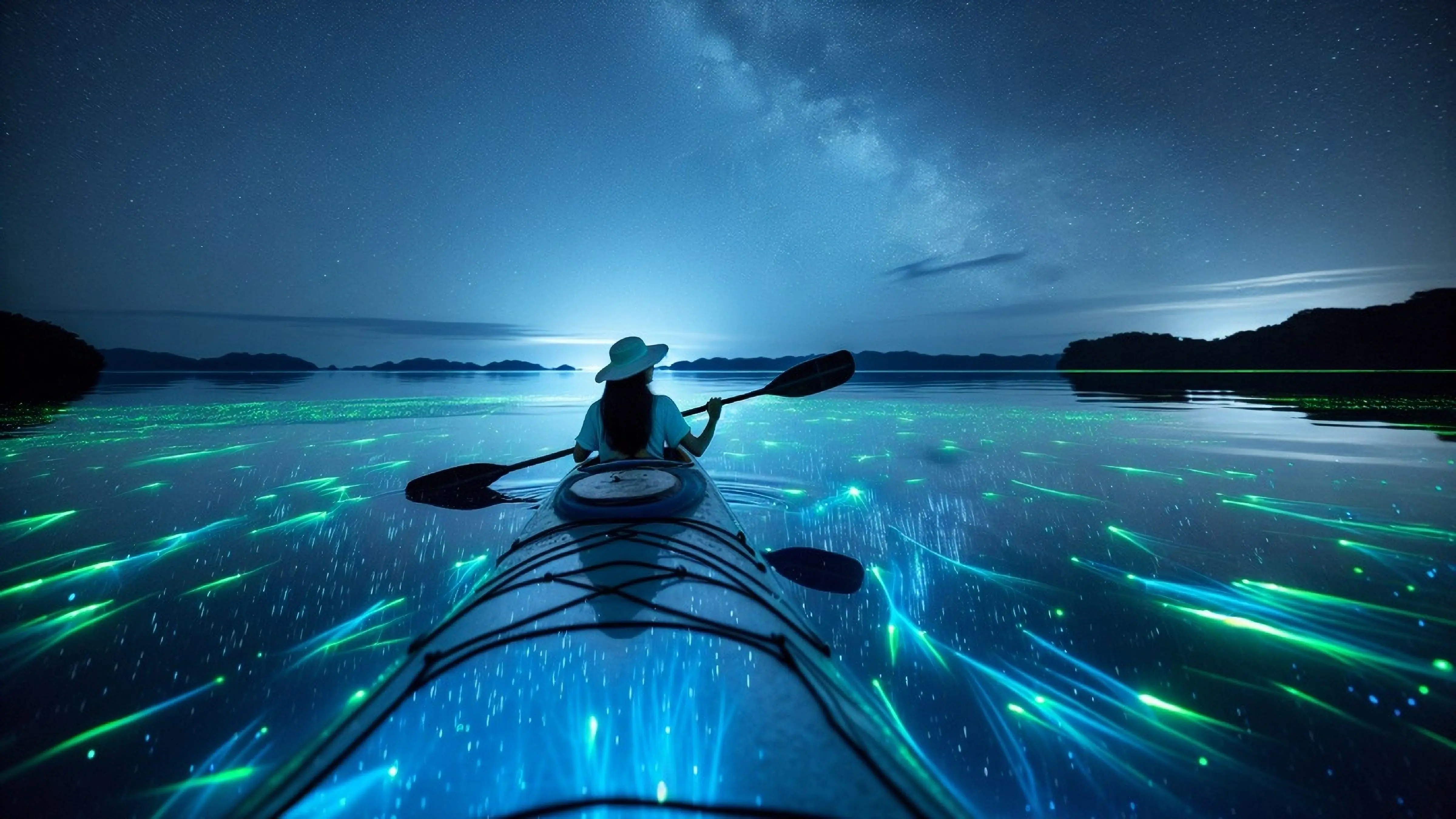
Bioluminescence often glows blueish, but individual organisms can create in a multitude of different colors.
One of the most magical outdoor experiences in the North Bay is happening right now—out on the water, after dark. Bioluminescent kayak tours are growing in popularity and the experience leaves visitors enchanted.
The National Ocean and Atmospheric Administration, or NOAA, describes bioluminescence as light emitted by a bioluminescent organism. Basically, there’s a single-cell type of plankton called dinoflagellates that float in warm, shallow waters near coastal areas. Wave disturbances cause a chemical reaction in the plankton, and they emit light. Bioluminescence often glows blueish, but individual organisms can create in a multitude of different colors.
The best time for seeing bioluminescence is at night during a new moon—which means being on the water in the dark. In the North Bay, there are several kayak companies that offer bioluminescent tours—leading paddlers through the night waters to see the light show.
Intense nights
Suki Waters runs WaterTreks Eco Tours (watertreks.com) from its home base in Jenner. Waters is of Pomo descent and was ingrained with a sense of ecological stewardship by her grandmother. She’s been sharing that wisdom as she shares the magic of the Russian River Estuary with her kayaking business. Her most magical tours happen as darkness falls across the water and the ocean slowly comes alive with bioluminescent light.
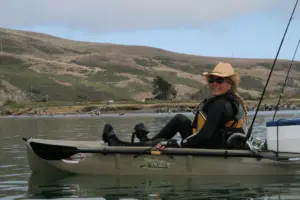
“The most intense nights, we’ve been throwing balls of light 30 feet behind our kayaks with each paddle stroke,” Waters says. “Every ripple lights up.”
The tours are made even more mesmerizing when sea life joins the fray.
“You can see the darting fish—and on the most intense nights you find out how many fish are in the estuary that you can’t normally see,” Waters says. “Harbor seals swim underneath and look up at you.”
Waters says that although bioluminescence is certainly visually beautiful, her true mission is to educate people. She’s doing that through a combination of her indigenous heritage and science.
As a child, Waters was taught to fish sustainably using a stick with twine made from dogsbane or waxed cotton thread, and using a rock for a sinker instead of lead. That way, she explains, if you break your line or hook it will all break down naturally in the water. “There’s not going to be a bunch of plastic left in the environment,” she says.
Waters helps monitor the health of the estuary and does water sampling and testing for the State of California. “There are algae blooms up on the Russian River that I get calls on,” she says. “It’s a different algae [than what’s encountered on her kayak tours]. Those types of toxic algae blooms upstream are behind stagnant freshwater.”
Waters says the best viewing is associated with warmer ocean waters and generally temperatures peak around the beginning of July. She laughs and mentions what she calls “global weirding” anomalies and the potential for changes to that timing.
“We start testing more near the end of June and moving forward,” she says. “The state wants to know if there’s an anomaly.”
Waters also explains that the extra nutrients fed into the estuary by the Russian River means a different experience compared with kayak tours of Tomales Bay. She says for that reason and because she loves supporting ecotourism, she encourages her guests to try the kayaking experiences in Tomales Bay, as well.
Teeming with wildlife
John Granatir and wife Pamalah MacNeily love kayaking together on Tomales Bay. “It’s just that stillness—and being in the natural world that makes it so special,” Granatir says. They’re helping others enjoy that same experience through their kayaking company.
The couple launched Blue Waters Kayaking (bluewaterskayaking.com) in 1994 and, although Granatir is now in his 70s, he is still training guides to lead kayaking tours. “I’ve probably been kayaking in the area for 40 years,” Granatir says, adding that he started the first kayaking company on Tomales Bay in 1984.
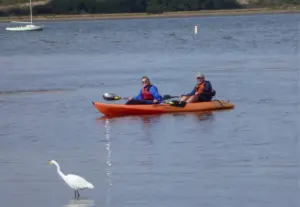
“Tomales Bay is a jewel of a place in terms of seeing beauty and access to nature that’s almost unparalleled,” Granatir says. “It’s teeming with wildlife. It’s a very rich biological resource.”
Their night tours for bioluminescence viewing are among their most popular and the time for best viewing is about to kick up again. Granatir laughs and says, “We call August ‘fogust’ around here.” He says on August evenings the fog rolls into Tomales Bay, creating the perfect conditions for bioluminescence viewing.
“It cuts down on the ambient light from the houses and roofs,” Granatir says. “So foggy nights in August are an ideal time for bioluminescence viewing.”
They schedule their tours based on the moon lunar cycle. “We start a couple of days after the full moon and go up to the new moon,” he says.
The experience can vary, but Granatir describes nights when the bioluminescence was brilliantly visible. “I mean, literally, you see the water dripping off your paddle and it’s like a little fiery cascade of water dripping off your paddle into the sea,” he says. “It’s quite magical.”
An unforgettable experience
Drew Dickson understands the value of local ecosystems and waterways. Dickson owns Napa Valley Paddle and the inspiration behind opening the kayaking business was down to his father’s legacy of saving a river.
Dickson grew up near the Napa River. “We were very familiar with what would become a healthy, biologically diverse waterway in the Bay Area,” he says. A $400 million living river restoration and flood control project was spearheaded by his late father, Dave Dickson, who worked for the county.
“We saw that evolve,” Dickson says. “We saw bird species nearly double.”
Dickson recognized the recreational opportunities on the Napa River and the potential to encourage the community to embrace their rehabilitated waterway with eco-tourism. He opened Napa Valley Paddle (napavalleypaddle.com) in 2012.
Most of their tours are done on the Napa River, following the tide up the river from the estuary past the town and into the forest.
However, when the moon is dark and the fog rolls onto the warm waters of Tomales Bay, Dickson heads west to lead bioluminescent kayak tours there.
“It’s like Fantasia under your kayak,” Dickson says. “This light-blue fluorescent light spills off of your kayak paddle and you get fluorescent light tracers that come off your kayak.”
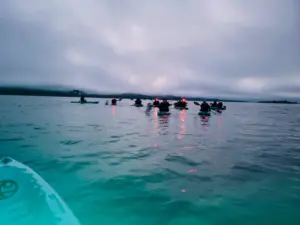
Dickson says they often see large schools of herring and anchovy that get startled by the kayak flotilla. “When they swim away you get these electric bolts, like electricity under the water’s surface,” he says.
They also do bat ray expeditions during certain tides. “When we find the bat rays, it’s literally like a 2-foot by 2-foot fluorescent diamond shape under your kayak that then swims away with these thick tracers that run for like 20 and 30 yards,” he says.
They sometimes see leopard sharks with their own distinct fluorescent shapes under the water, as well. “We’ll find schools that are so large it’s like a light switch flips on underneath the ocean and there’s so much light given off by the bioluminescence that you can literally see the herring in the middle of the night in pitch black darkness.”
Adds Dickson: “The amount of life, the warm water, the rugged coastline and then the amount of bioluminescence that exists—it’s just an unforgettable experience.”



